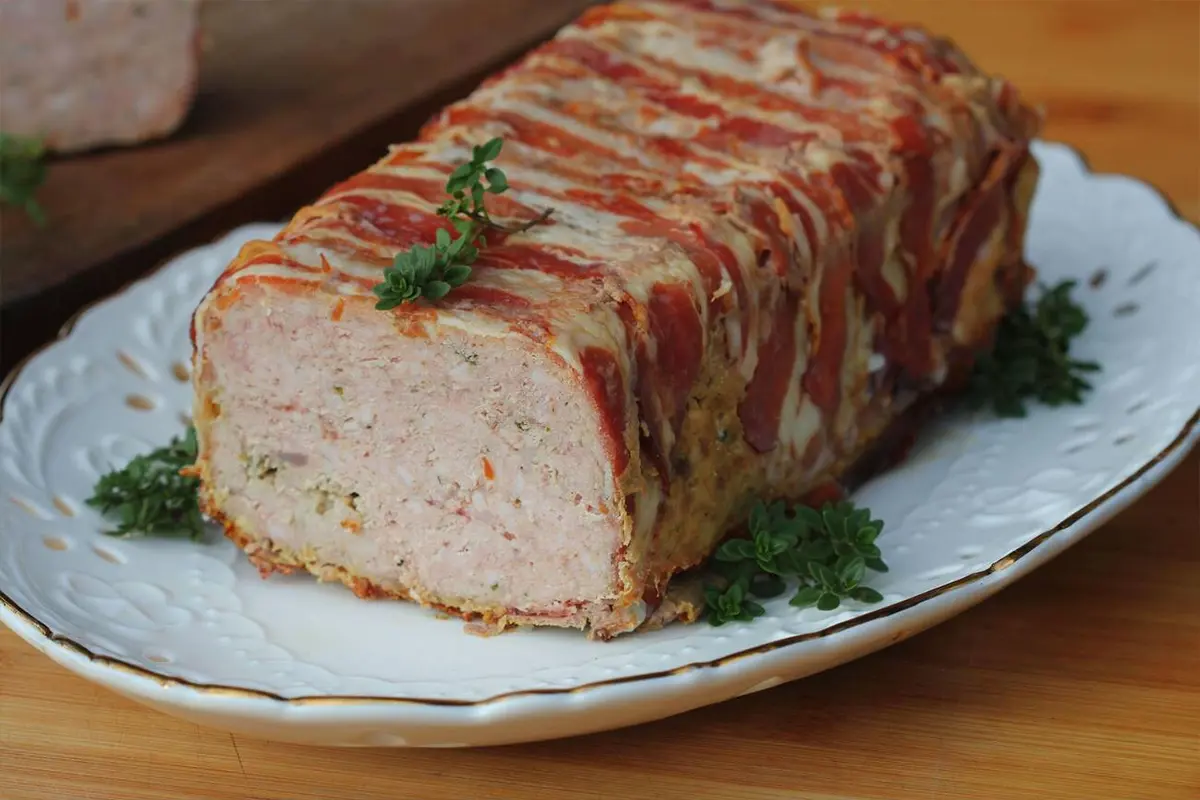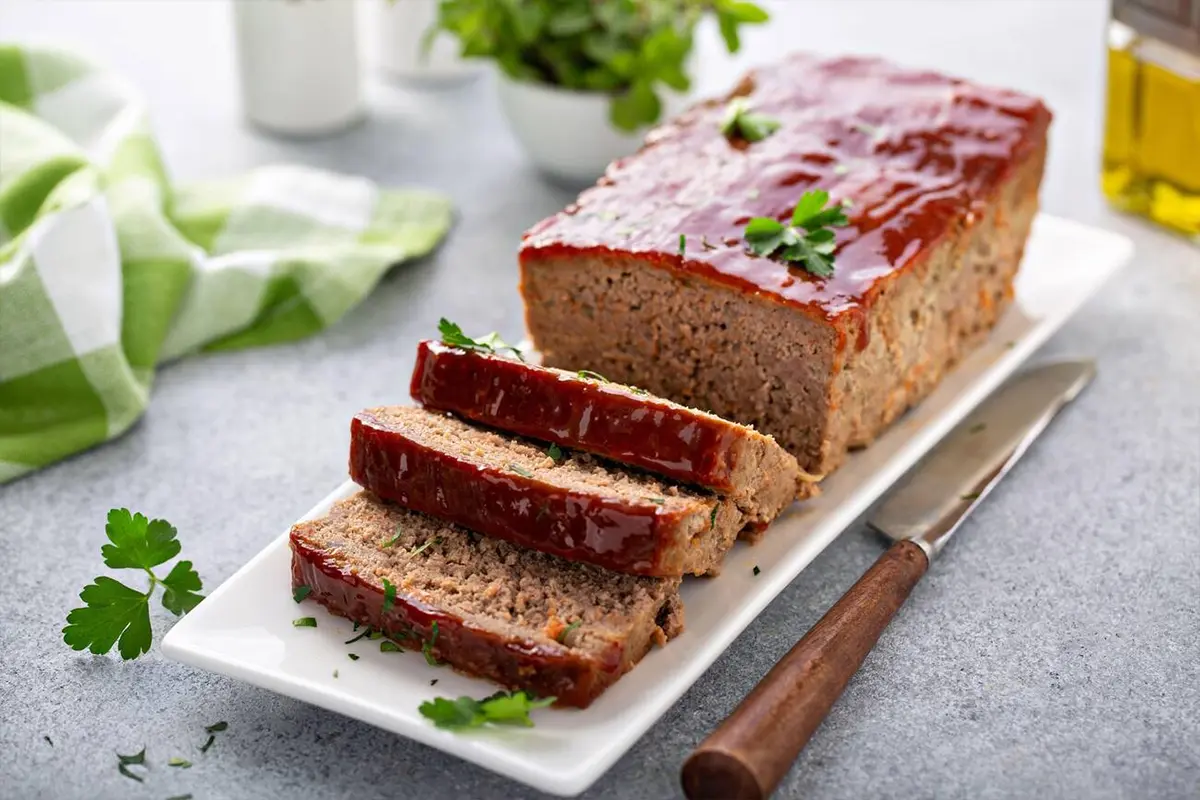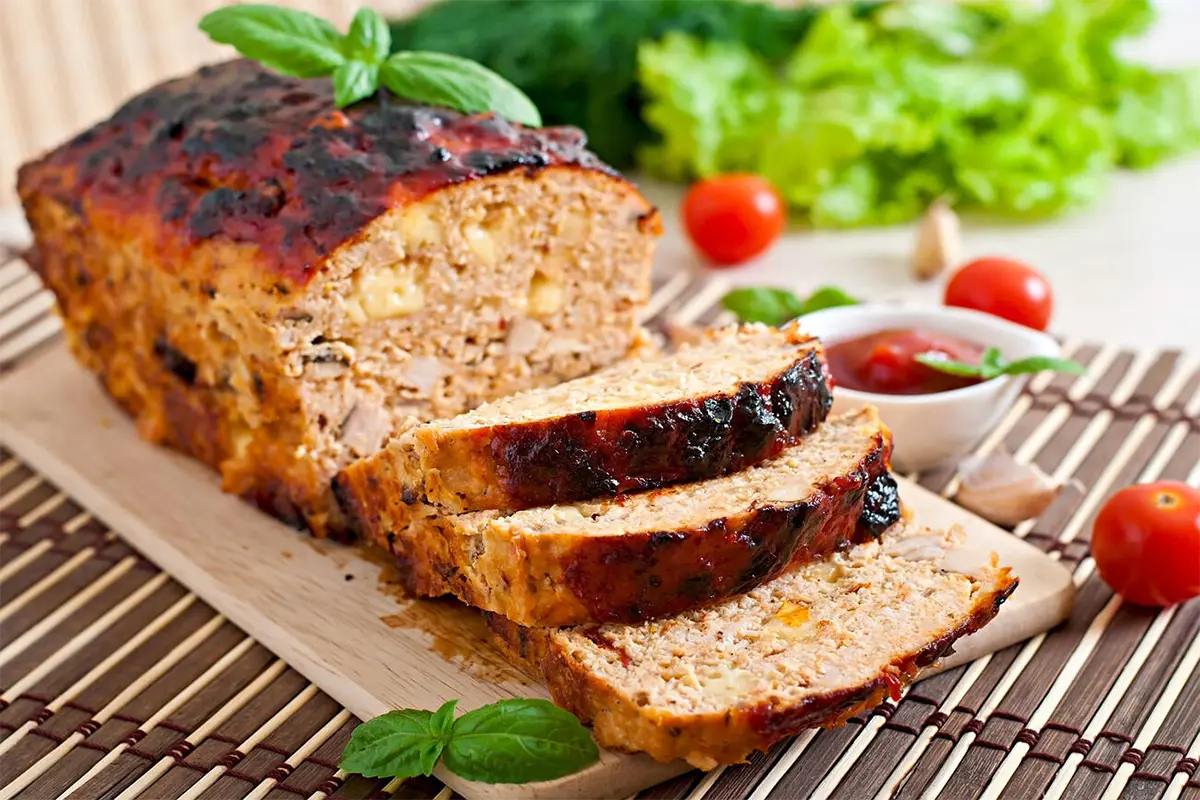Introduction to Meatloaf Perfection
The Timeless Appeal of Meatloaf
Ah, meatloaf! It’s the quintessential comfort food that brings back fond memories of family dinners. Indeed, the appeal of meatloaf isn’t just in its taste but also in its ability to adapt and evolve. Whether you stick to the classic recipe or jazz it up with unique spices and ingredients, meatloaf never fails to satisfy.
Meatloaf Cooking Hacks: An Overview of Meatloaf’s Culinary Evolution
Now, let’s take a stroll down memory lane. Meatloaf began as a simple, budget-friendly option during times when stretching the pantry was essential. Fast forward to today, and it’s a dish celebrated for its versatility. The evolution of meatloaf reflects a fascinating blend of tradition and innovation, where every ingredient counts.
Introducing a Simple Yet Game-Changing Hack
And here’s a juicy tidbit for you: placing bread slices directly under your meatloaf. Sounds pretty straightforward, right? But believe me, this simple hack will revolutionize how you cook meatloaf by tackling the all-too-common issue of grease absorption while improving the overall texture. So, stay tuned as we delve deeper into how this neat trick can turn your meatloaf around, making it less greasy yet more delicious than ever!
The Secret of Bread at the Bottom
Why Bread Belongs Under Your Meatloaf
Ever wondered why your meatloaf might turn out a bit too greasy? Here’s a straightforward solution: put bread slices at the bottom! This technique not only catches excess fat but also enhances the meal’s overall texture and flavor. Moreover, it makes cleanup a breeze. So, if you’re aiming for a juicier, tastier meatloaf, don’t skip the bread!
Meatloaf Cooking Hacks: The Dual Purpose of Bread Slices
Now, let’s talk about the bread’s role. First, the bread acts as a sponge, absorbing excess grease that meat releases during cooking. This means you won’t end up with a pool of fat at the bottom of your pan. Secondly, these soaked bread slices transform into a delectable side dish. Once they soak up all that flavorful juice, they become a treat that perfectly complements your meatloaf.
From Grease Absorber to Tasty Side Dish
And here’s the best part: after absorbing all the grease, the bread undergoes a delightful transformation. It turns into a crispy, savory side that pairs wonderfully with your meatloaf. Just imagine the combination of soft, juicy meatloaf with crispy, umami-packed bread. Now that’s a hack that serves more purposes than one! So next time, remember this simple trick for a cleaner, tastier meatloaf experience.
How Bread Enhances Meatloaf
Beyond Grease Absorption: The Culinary Benefits
Indeed, the role of bread under meatloaf goes beyond mere grease absorption; it significantly boosts the dish’s culinary appeal. By absorbing the meat’s juices, the bread enhances the flavors within the meatloaf, distributing them evenly and adding a moist, tender texture to every bite. Therefore, this method not only simplifies cleanup but also elevates the eating experience.

Improving Texture and Flavor
Furthermore, the bread at the bottom impacts the meatloaf’s texture and flavor in positive ways. As the meat cooks, its natural juices seep into the bread, infusing it with rich, meaty flavors that would otherwise just drip away. This process ensures that every slice of meatloaf is moist, tender, and packed with flavor, making the dish even more enjoyable.
Alternative Solutions to Meatloaf Grease
However, if bread isn’t your go-to, there are other ways to handle excess grease in meatloaf. For instance, placing a wire rack in the pan lets the fat drip away from the meat, resulting in a less greasy but still moist meatloaf. Alternatively, mixing absorbent ingredients like oatmeal or grated vegetables directly into the meatloaf can also help manage the grease while adding nutritional value and enhancing the texture. These methods provide various options to achieve that perfect meatloaf consistency, whether you use bread or not.
Selecting the Right Bread
White Bread Versus Whole Grain: Making the Best Choice
Choosing the right type of bread to place under your meatloaf makes a big difference. White bread, soft and highly absorbent, is excellent for soaking up juices and fats, ensuring they stay within the dish. On the other hand, whole grain bread, with its denser texture and added nutrients, can add a hearty flavor and extra fiber to your meal. So, think about what matters more for your meal: maximum absorption or a nutritional boost?
Meatloaf Cooking Hacks: Exploring the Impact of Different Breads
Each type of bread impacts your meatloaf differently. For instance, white bread tends to meld seamlessly into the dish, almost disappearing into the meatloaf’s base. In contrast, whole grain bread retains its structure better and can add a slight crunchiness to the meal’s foundation. Therefore, your choice should align with the desired final texture and flavor profile of your meatloaf.
Other Absorptive Substitutes
If you’re looking for alternatives to bread, several other options can absorb grease effectively while adding their unique twist to the dish. For example, you could use mashed potatoes for a creamy texture or cooked rice for a gluten-free option that still captures excess moisture and fat. These substitutes not only help manage grease but also introduce new textures and flavors, making your meatloaf even more special.
The Impact on Meatloaf Texture
How Bread Affects the Moisture and Texture of Meatloaf
Placing bread beneath your meatloaf significantly influences its moisture and overall texture. This simple addition ensures that the meat remains juicy and tender. The bread absorbs excess fats and juices, which helps to maintain the desired moistness without making the meatloaf soggy.
Keeping Meatloaf Moist Without the Sogginess
To keep your meatloaf moist but not soggy, the key is in the type and amount of bread you use. Thinly sliced white bread works best as it absorbs moisture efficiently without becoming overly wet. This method allows you to enjoy a meatloaf that is perfectly moist on the inside and wonderfully crusty on the outside.
Meatloaf Cooking Hacks: The Role of Bread in Meat Binding
Moreover, bread plays a crucial role in binding the ingredients of your meatloaf. As it absorbs juices, it helps to bind the meat, vegetables, and seasonings together, creating a firm yet tender texture. This makes the loaf easier to slice and serve, enhancing the overall presentation and enjoyment of the dish.
A Comparative Analysis of Cooking Methods
Baking Sheet Versus Loaf Pan: A Meatloaf Debate
When it comes to cooking meatloaf, the choice between using a baking sheet or a loaf pan can greatly affect the outcome. This debate centers around how these methods influence the meatloaf’s texture and flavor.
The Case for Cooking on a Baking Sheet
Cooking meatloaf on a baking sheet offers several advantages. Firstly, it allows the heat to circulate freely around the meatloaf, ensuring an even cook and a crisper exterior. Moreover, the increased surface area lets more of the fat drain away, resulting in a leaner and healthier dish. Also, this method gives you the flexibility to shape the meatloaf to your preference, which can enhance presentation and serving.
Benefits of the Traditional Loaf Pan Approach
Conversely, using a traditional loaf pan has its own set of benefits. The pan holds the meatloaf together, allowing it to cook in its own juices, which can intensify flavors and keep the meat exceptionally moist. Additionally, the loaf pan’s shape provides a consistent size and form, making it easier to slice and serve. This method is ideal for those who prefer a juicier, more traditional meatloaf.
Meatloaf Techniques: Recipe Spotlight on Perfect Meatloaf With Bread Base

Crafting the Ultimate Meatloaf: Ingredients and Directions
Creating the perfect meatloaf starts with gathering the right ingredients and following specific steps to ensure everything melds together beautifully. Below, we’ll go through everything you need to make a meatloaf that’s both delicious and visually appealing.
Meatloaf Cooking Hacks: Ingredient List with a Focus on the Bread Base
Here’s what you’ll need:
- 2 pounds of ground beef (lean)
- 1 cup of milk
- 2 eggs
- 1/2 cup of diced onions
- 1/2 cup of diced bell peppers
- 1 cup of breadcrumbs
- 4 slices of white bread
- 1 tablespoon of Worcestershire sauce
- Salt and pepper to taste
- 1/2 cup of ketchup or barbecue sauce for topping
Detailed Cooking Instructions
- Preheat your oven to 375°F (190°C).
- In a large bowl, combine the ground beef, milk, eggs, onions, bell peppers, breadcrumbs, Worcestershire sauce, salt, and pepper.
- Mix all the ingredients thoroughly until well combined.
- Place the bread slices at the bottom of a baking sheet, forming a base.
- Mold the meat mixture into a loaf shape and place it on top of the bread slices.
- Spread the ketchup or barbecue sauce over the top of the meatloaf.
- Bake in the preheated oven for about 1 hour or until the meatloaf is cooked through and the juices run clear.
- Let the meatloaf rest for 10 minutes before slicing. This helps the juices redistribute and makes the meatloaf easier to slice.
Meatloaf Cooking Hacks: Tips for Maximizing Flavor and Texture
- Adding a splash of Worcestershire sauce or a pinch of dried herbs like oregano or thyme can greatly enhance the meatloaf’s flavor.
- Keep an eye on the oven; cooking times can vary. The key is to ensure the meatloaf reaches an internal temperature of 160°F (71°C).
- Consider topping the meatloaf with strips of bacon before baking for an extra layer of flavor and a crispier top.
- Using bread as a base not only soaks up excess grease but also adds a slight crunch that contrasts nicely with the tender texture of the meatloaf above.
By following these steps and tips, you’ll craft a meatloaf that not only tastes great but also presents beautifully, making it a sure hit at any dining table.
FAQs – Answering Common Meatloaf Questions
Meatloaf Cooking Hacks: Expert Insights on Meatloaf Preparation
Tackling common meatloaf issues can make all the difference in your cooking results. Here, we answer some frequently asked questions with expert advice to improve your meatloaf preparation.
Can I use gluten-free bread for the bottom layer?
Absolutely, you can use gluten-free bread as the base for your meatloaf. It absorbs grease just as well as regular bread and works great for those avoiding gluten. Make sure it’s sturdy enough to hold up under the meatloaf without disintegrating.
What can I do if my meatloaf is still too greasy?
If your meatloaf turns out too greasy, consider a few strategies. First, increase the amount of bread at the base to soak up more fat. Also, leaner meat cuts can significantly reduce grease. Lastly, baking the meatloaf on a wire rack allows the fat to drip away from the meat.
How can I make my meatloaf more flavorful?
Enhancing your meatloaf’s flavor is easy with a few tweaks. Add rich umami ingredients like Parmesan cheese, Worcestershire sauce, or sun-dried tomatoes. Fresh herbs, such as parsley or basil, also brighten the dish. For a bold twist, mix in a small amount of spicy sausage with the ground beef. These additions ensure a flavorful meatloaf that stands out at any meal.
Meatloaf Cooking Hacks: Advanced Tips for Meatloaf Enthusiasts
Elevating Your Meatloaf to Gourmet Levels
Taking your meatloaf from good to gourmet isn’t as hard as it might seem. By incorporating a few expert tips, you can enhance both the flavor and presentation of your meatloaf, making it a standout dish at any dinner.
Meatloaf Cooking Hacks: Creative Twists on the Bread Base Method
Switching up the bread base can add an unexpected twist to your meatloaf. Try using garlic bread for a flavorful base, or ciabatta for a rustic feel. Another idea is to mix herbs like rosemary or thyme into your bread slices before placing them under the meatloaf, infusing the loaf with these aromatics as it cooks.
Pairing and Serving Suggestions for Enhanced Dining Experience
Pair your meatloaf with side dishes that complement its rich flavors. A light, tangy coleslaw or a crisp green salad can balance the hearty nature of meatloaf. For a truly enhanced dining experience, serve your meatloaf with a homemade glaze or gravy on the side. This not only adds moisture but also boosts the flavor profile of the dish, making each bite deliciously satisfying.
LSI and NLP Keywords
- Meatloaf cooking hacks
- Bread slices meatloaf pan
- Meatloaf moisture control
- Meatloaf grease absorption
- Gluten-free meatloaf tips
- Flavorful meatloaf recipes
- Meatloaf texture improvements
- Cooking meatloaf without sogginess
External Links and Recommended Anchor Text
- Culinary Institute of America’s Meatloaf Tips – “Professional Meatloaf Cooking Techniques”
- Food Safety Guidelines for Ground Beef – “Ensuring Safety in Meatloaf Preparation”
- History of Meatloaf – “Exploring the Origins of Meatloaf”

